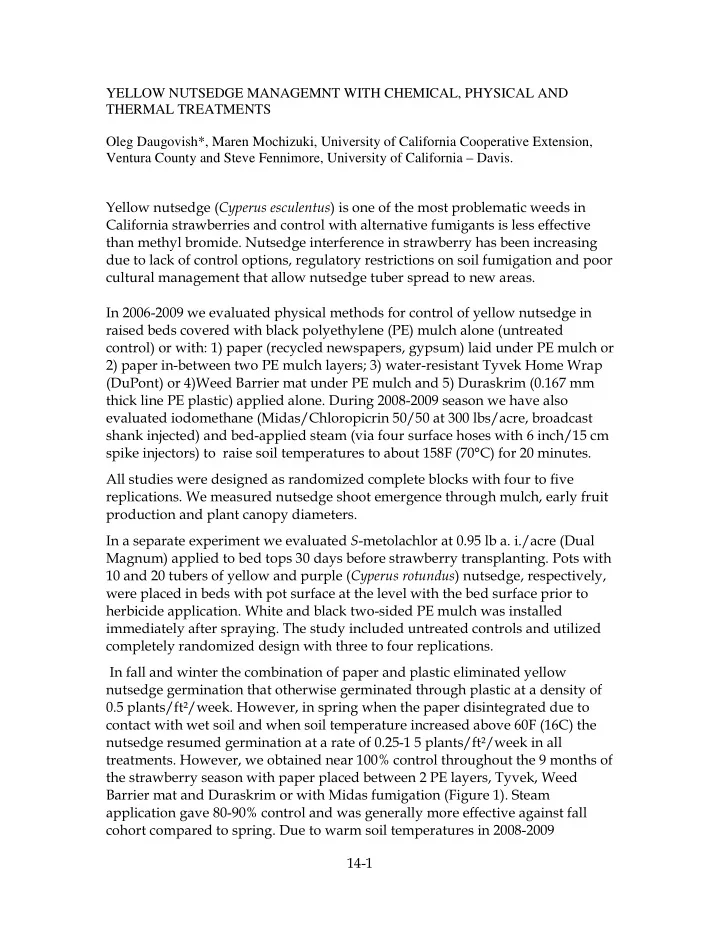

YELLOW NUTSEDGE MANAGEMNT WITH CHEMICAL, PHYSICAL AND THERMAL TREATMENTS Oleg Daugovish*, Maren Mochizuki, University of California Cooperative Extension, Ventura County and Steve Fennimore, University of California – Davis. Yellow nutsedge ( Cyperus esculentus ) is one of the most problematic weeds in California strawberries and control with alternative fumigants is less effective than methyl bromide. Nutsedge interference in strawberry has been increasing due to lack of control options, regulatory restrictions on soil fumigation and poor cultural management that allow nutsedge tuber spread to new areas. In 2006-2009 we evaluated physical methods for control of yellow nutsedge in raised beds covered with black polyethylene (PE) mulch alone (untreated control) or with: 1) paper (recycled newspapers, gypsum) laid under PE mulch or 2) paper in-between two PE mulch layers; 3) water-resistant Tyvek Home Wrap (DuPont) or 4)Weed Barrier mat under PE mulch and 5) Duraskrim (0.167 mm thick line PE plastic) applied alone. During 2008-2009 season we have also evaluated iodomethane (Midas/Chloropicrin 50/50 at 300 lbs/acre, broadcast shank injected) and bed-applied steam (via four surface hoses with 6 inch/15 cm spike injectors) to raise soil temperatures to about 158F (70°C) for 20 minutes. All studies were designed as randomized complete blocks with four to five replications. We measured nutsedge shoot emergence through mulch, early fruit production and plant canopy diameters. In a separate experiment we evaluated S -metolachlor at 0.95 lb a. i./acre (Dual Magnum) applied to bed tops 30 days before strawberry transplanting. Pots with 10 and 20 tubers of yellow and purple ( Cyperus rotundus ) nutsedge, respectively, were placed in beds with pot surface at the level with the bed surface prior to herbicide application. White and black two-sided PE mulch was installed immediately after spraying. The study included untreated controls and utilized completely randomized design with three to four replications. In fall and winter the combination of paper and plastic eliminated yellow nutsedge germination that otherwise germinated through plastic at a density of 0.5 plants/ft²/week. However, in spring when the paper disintegrated due to contact with wet soil and when soil temperature increased above 60F (16C) the nutsedge resumed germination at a rate of 0.25-1 5 plants/ft²/week in all treatments. However, we obtained near 100% control throughout the 9 months of the strawberry season with paper placed between 2 PE layers, Tyvek, Weed Barrier mat and Duraskrim or with Midas fumigation (Figure 1). Steam application gave 80-90% control and was generally more effective against fall cohort compared to spring. Due to warm soil temperatures in 2008-2009 14-1
nutsedge shoots continued to emerge throughout the season in untreated controls at 5 to 25 plants per 100ft² (9m²) per week in fall and 35 to 45 plants in spring. Approximate expenses for hand-weeding at these weed densities and frequency would be $5, 000 to $6,000 /acre and will require labor diversion from fruit harvest during the greatest fruit load (spring). In the absence of other control methods, physical barriers can be economical at high nutsedge densities with approximate costs per acre of $1,200 (paper between 2 plastic layers), $4,300 (Weed Barrier), $4,799 (Tyvek) and $6,500 (Duraskrim). Since no deterioration of Duraskrim, Tyvek or Weed barrier occurred after 9 month it may be possible to reuse these materials in following season, thus, reducing seasonal costs. Since no fumigation was done under physical barriers the plants were slightly smaller and had less fruit than either in steam or Midas treatments (Figures 2 and 3). Duraskrim and Weed Barrier mat also restricted plant crown division and growth in some planting holes that were cut not sufficiently large. If these materials are used, care should be taken to assure that all planting holes are properly cut and that plant placement at planting is adequate for optimum establishment. Plants in beds treated with steam appeared healthy and as productive as in Midas treatment, however, nutsedge control with Midas was superior to that of steam application. Greater uniformity of lethal temperatures in future steam applications will assure complete weed control. Soil analyses showed that levels of carbon decreased slightly, while the levels of plant available iron and manganese more than doubled after steam application reaching 17 and 24 ppm, respectively, which may have had a positive effect on plant growth in steamed beds. In experiments with Dual Magnum purple and yellow nutsedge control was near 90 and 100%, respectively, suggesting the usefulness of this herbicide in pre- plant nutsedge management program. Strawberry performance in treated areas is currently under investigation. In summary, this research identified Midas and Dual Magnum as effective chemical tools in the integrated management of nutsedge in conventional strawberry production. Physical barriers were very effective and may be justified in areas with high nutsedge density but need to be used in combination with other soil disinfestation treatments. Steam also provided very good nutsedge control while also sterilizing the soil from pests and pathogens and, therefore can be applied alone. Physical barriers and steam are especially valuable in areas were fumigation is not permitted such as buffer zones or organic strawberry production. 14-2
50 Control Duraskrim Midas 40 Plastic-paper-plastic Number of nutsedge shoots Steam Tyvek 30 Weed barrier 20 10 0 Oct Nov Dec Jan 2009 Feb Mar Apr May June Date Figure 1. Total number of yellow nutsedge shoots germinating through plastic (not in strawberry planting holes) every month from Oct. 2008 through June 2009. Shoots were counted and removed each week. Bars represent standard error. Figure 2. Strawberry plant canopy diameter (length × width) measured on Nov. 18 and three weeks later on Dec. 8. Values are an average of 20 plants per treatment per replication; means with the same letters within a date are not significantly different at P <0.05. 14-3
Figure 3. Number of white and red fruit counted weekly after commercial harvest began; values represent the average number of fruit per treatment per month as a non-destructive yield estimate. Bars are standard errors. 14-4
Recommend
More recommend